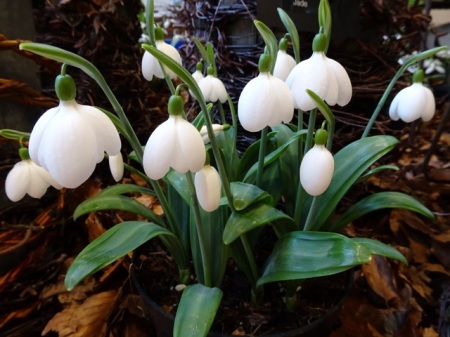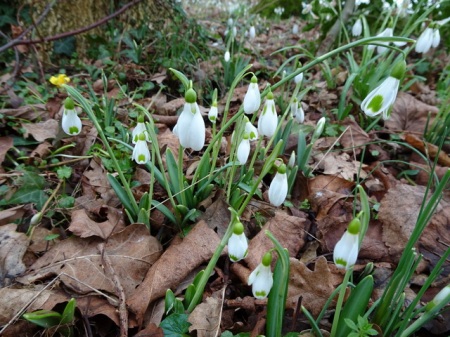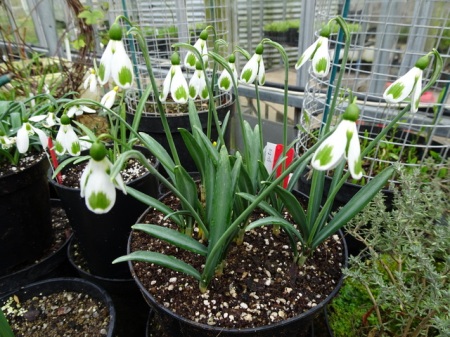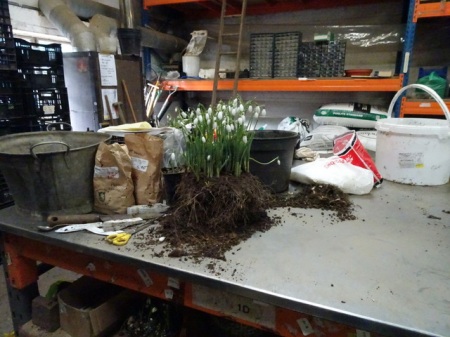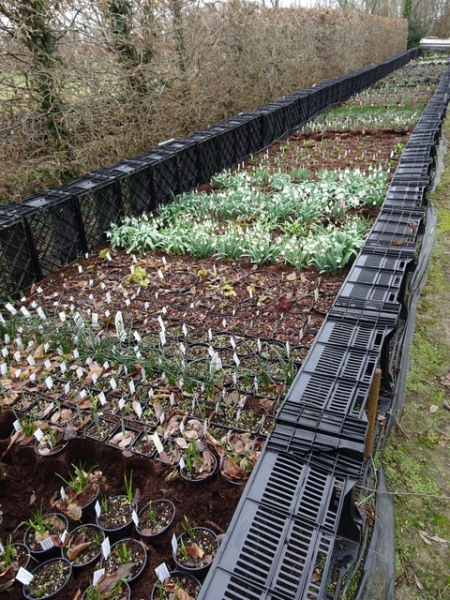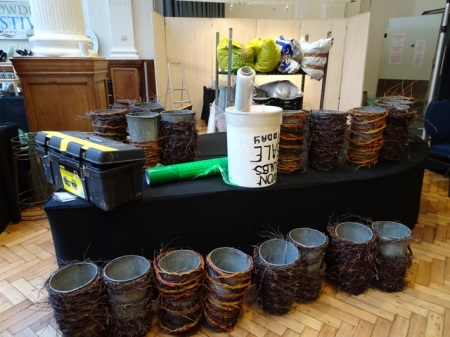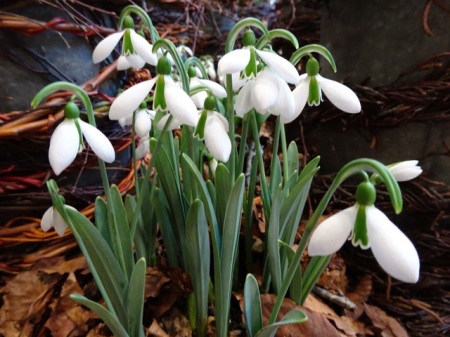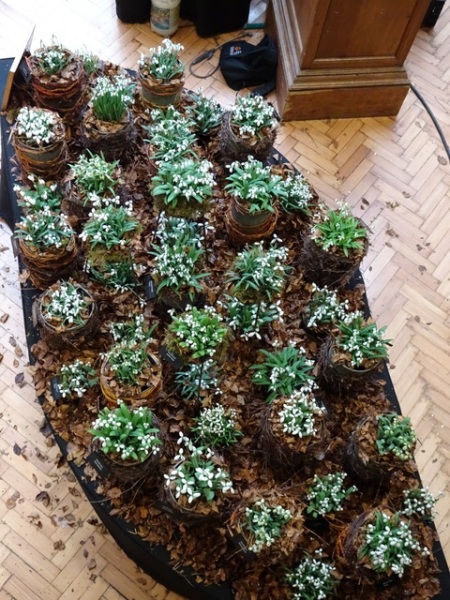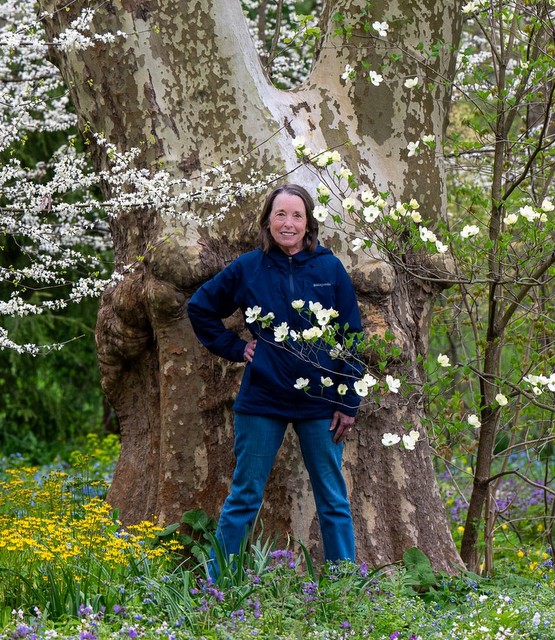 ‘E. A. Bowles’ is in a class by itself, shown here at Carolyn’s Shade Gardens.
‘E. A. Bowles’ is in a class by itself, shown here at Carolyn’s Shade Gardens.
Our current snowdrop catalogue is on line here.
.
. ‘E.A. Bowles’ caused a sensation in 2011 when it sold for the highest recorded price ever paid for a snowdrop.
‘E.A. Bowles’ caused a sensation in 2011 when it sold for the highest recorded price ever paid for a snowdrop.
‘E.A. Bowles’ invites the use of every over-the-top adjective in the snowdrop lexicon and, if I was forced to pick a favorite snowdrop, this would be it. It towers over other snowdrops and produces gigantic, magnificent, pure white flowers that are perfectly poculiform, meaning all six segments are outer segments. It blooms very late in the season and, with its height and flower size, could easily be mistaken for a white daffodil. It is a G. plicatus cultivar, and its broad, shiny green leaves only add to the allure.
.
 ‘E.A. Bowles’ prominently featured in the Avon Bulbs display at the 2018 RHS Show.
‘E.A. Bowles’ prominently featured in the Avon Bulbs display at the 2018 RHS Show.
‘E.A. Bowles’ was discovered in 2002 by North Yorkshire snowdrop expert Michael Myers at Myddelton House, Enfield, Middlesex, the former home and garden of famous plantsman E.A. Bowles (1865-1954). Its status as an outstanding snowdrop was immediately apparent, and it received a Royal Horticultural Society Award of Garden Merit. In 2011, it was the first snowdrop to receive significant attention from the non-gardening press when it fetched the then mind boggling price of £357 at auction.
.
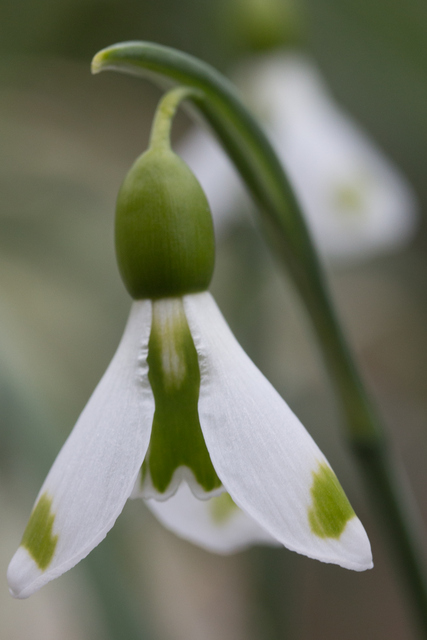 ‘The Wizard’
‘The Wizard’
‘The Wizard’s’ lighter green, heart-shaped markings on the large outer segments paired with the almost completely green inner segments result in an enchanting snowdrop. It has the traditional, pagoda-like shape of an inverse poculiform, where all the outer segments have been replaced by a whorl of inners, and a tall, upright habit with the lovely leaves characteristic of a G. plicatus.
It was discovered by snowdrop expert Alan Street in the copse at Avon Bulbs and first offered for sale in 2014. Although there are many ‘Trym’-like snowdrops available now, ‘The Wizard’ cast its spell over Anne Repnow and was included in her new book profiling only 90 out of over 2,500 named snowdrop cultivars. For a review of her wonderful book, click here.
 ‘Mrs. Thompson’s’ erratic behavior is highly prized in the snowdrop world.
‘Mrs. Thompson’s’ erratic behavior is highly prized in the snowdrop world.
‘Mrs. Thompson’ defies snowdrop norms. Uniformity is usually highly prized among snowdrop collectors, but, paradoxically, this snowdrop’s erratic behavior has made it more desirable. Along with an elegant and stately classic flower, when well established, it also produces twins (two flowers with separate pedicels on the same scape), fused flowers, and flowers with 4, 5, or even 6 outer segments. Rather than detracting from the beauty of the clump, these quirks make ‘Mrs. Thompson’ enchanting.
.
 The left flower has five outer segments instead of the usual three, and the right flower is composed of two fused flowers on the same scape.
The left flower has five outer segments instead of the usual three, and the right flower is composed of two fused flowers on the same scape.
‘Mrs. Thompson’ was discovered by Mrs. N.G. Thompson of Red House, Escrick, York, and was sent by her to the RHS Scientific Committee, chaired by E.A. Bowles, for consideration in 1950.
.
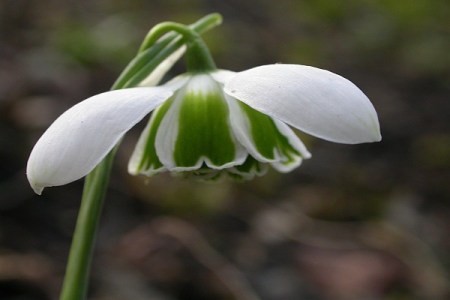 ‘Cordelia’ produces a very neat, green rosette.
‘Cordelia’ produces a very neat, green rosette.
‘Cordelia’ is a beautiful and elegant double snowdrop originated prior to 1954 by English plantsman Heyrick Greatorex as part of his famous series of large and vigorous double snowdrops, resulting from his crosses of G. plicatus with G. nivalis ‘Flore Pleno’. He named his doubles after characters in Shakespeare’s plays—here the youngest daughter in King Lear.
.
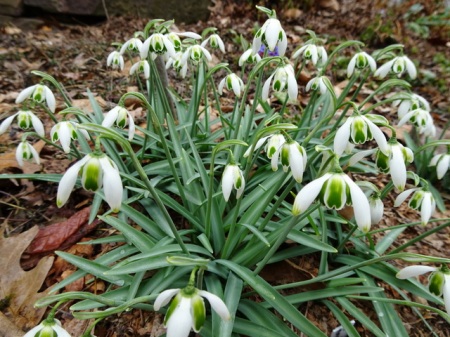 ‘Cordelia’ at Carolyn’s Shade Gardens
‘Cordelia’ at Carolyn’s Shade Gardens
‘Cordelia’ is one of the lesser known but more easily identifiable Greatorex doubles due to its large, variable, green inner marking, superior height, and very uniform and neat rosette. It thrives in my garden!
.
 ‘Phantom’ produces two types of flowers. One is the very lovely, pure white poculiform shown above. This is the flower form that appears if only one flower is produced.
‘Phantom’ produces two types of flowers. One is the very lovely, pure white poculiform shown above. This is the flower form that appears if only one flower is produced.
.
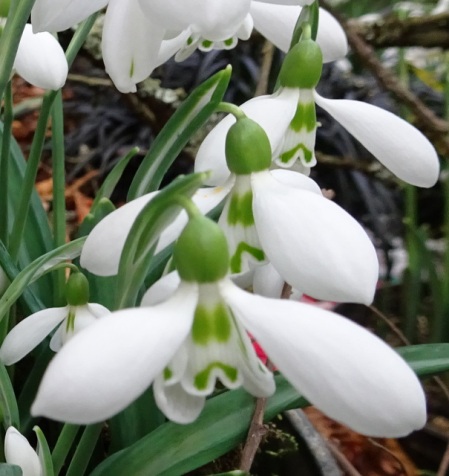 This is ‘Phantom’s’ other flower type: a spooky looking snowdrop with markings configured like G. plicatus subsp. byzantinus.
This is ‘Phantom’s’ other flower type: a spooky looking snowdrop with markings configured like G. plicatus subsp. byzantinus.
‘Phantom’ is a very mysterious snowdrop of unknown origin and previously unknown configuration. When established, it produces two very different flowers from the same bulb.
The first is a beautiful, large, pure white, six-petaled poculiform like ‘E.A. Bowles’. The second is a flower with basal and apical markings on the inner segments like G. plicatus subsp. byzantinus. The markings on the second flower resemble large and elongated eyes and a down-turned mouth, very phantom-like, which may have contributed to the name.
.
 Both types of flowers appear on this beautiful specimen shown by Avon Bulbs at the 2017 RHS Show.
Both types of flowers appear on this beautiful specimen shown by Avon Bulbs at the 2017 RHS Show.
The mystery continues with ‘Phantom’s’ origin. It was introduced in 2015 by Alan Street at Avon Bulbs, but the collector from whom he thought he got it denies giving it to him.
.
Blogs are a lot more fun for everyone, especially the writer, when readers leave comments. Scroll down to the end of the page to the box where it says “Leave a Reply” and start typing—-it’s easy!
Carolyn
.
Note: Every word that appears in orange on my blog is a link that you can click for more information. If you want to return to my blog’s homepage to access the sidebar information (catalogues, previous articles, etc.) or to subscribe to my blog, just click here.
 ‘Midas’ has yellow marks on the outer segments, something entirely new to the snowdrop world.
‘Midas’ has yellow marks on the outer segments, something entirely new to the snowdrop world. Alan Street at Avon Bulbs sent me this photo of ‘Midas’ in 2017, the year it was introduced. I couldn’t believe my eyes—here was a swarm of one of the world’s rarest snowdrops!
Alan Street at Avon Bulbs sent me this photo of ‘Midas’ in 2017, the year it was introduced. I couldn’t believe my eyes—here was a swarm of one of the world’s rarest snowdrops!
 ‘Augustus’ is classically elegant and award-winning.
‘Augustus’ is classically elegant and award-winning. ‘Augustus’ is very striking in a group, here in Hilary and Hugh Purkess’s garden “Welshway”.
‘Augustus’ is very striking in a group, here in Hilary and Hugh Purkess’s garden “Welshway”. ‘Cowhouse Green’, shown here at Carolyn’s Shade Gardens.
‘Cowhouse Green’, shown here at Carolyn’s Shade Gardens. ‘Desdemona’ is a Greatorex double snowdrop.
‘Desdemona’ is a Greatorex double snowdrop. ‘Desdemona’ at Evenley Wood Garden in Northhamptonshire, a snowdrop venue well worth visiting.
‘Desdemona’ at Evenley Wood Garden in Northhamptonshire, a snowdrop venue well worth visiting. ‘Moses Basket’ cannot be mistaken for any other snowdrop. Many thanks to Margaret and David MacLennan, holders of the UK National Collection of Galanthus (Scientific), for the wonderful photo.
‘Moses Basket’ cannot be mistaken for any other snowdrop. Many thanks to Margaret and David MacLennan, holders of the UK National Collection of Galanthus (Scientific), for the wonderful photo. ‘Rodmarton Arcturus’ at the famous snowdrop destination Rodmarton Manor in England.
‘Rodmarton Arcturus’ at the famous snowdrop destination Rodmarton Manor in England. An enviable clump of ‘Rodmarton Arcturus’ in the garden of snowdrop expert Ronald Mackenzie.
An enviable clump of ‘Rodmarton Arcturus’ in the garden of snowdrop expert Ronald Mackenzie.